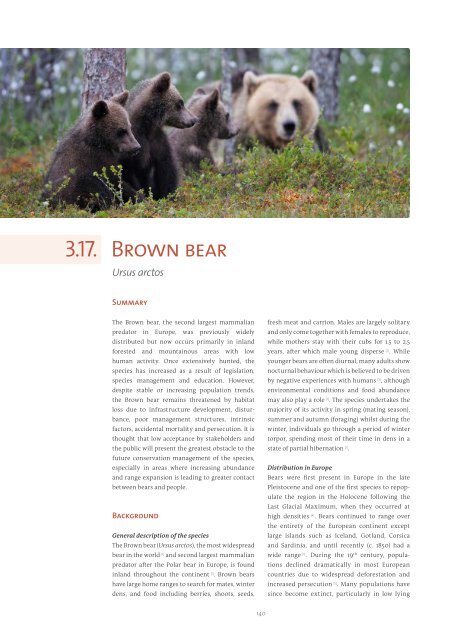130925-studie-wildlife-comeback-in-europe
Create successful ePaper yourself
Turn your PDF publications into a flip-book with our unique Google optimized e-Paper software.
3.17. Brown bear<br />
Ursus arctos<br />
Summary<br />
The Brown bear, the second largest mammalian<br />
predator <strong>in</strong> Europe, was previously widely<br />
distributed but now occurs primarily <strong>in</strong> <strong>in</strong>land<br />
forested and mounta<strong>in</strong>ous areas with low<br />
human activity. Once extensively hunted, the<br />
species has <strong>in</strong>creased as a result of legislation,<br />
species management and education. However,<br />
despite stable or <strong>in</strong>creas<strong>in</strong>g population trends,<br />
the Brown bear rema<strong>in</strong>s threatened by habitat<br />
loss due to <strong>in</strong>frastructure development, disturbance,<br />
poor management structures, <strong>in</strong>tr<strong>in</strong>sic<br />
factors, accidental mortality and persecution. It is<br />
thought that low acceptance by stakeholders and<br />
the public will present the greatest obstacle to the<br />
future conservation management of the species,<br />
especially <strong>in</strong> areas where <strong>in</strong>creas<strong>in</strong>g abundance<br />
and range expansion is lead<strong>in</strong>g to greater contact<br />
between bears and people.<br />
Background<br />
General description of the species<br />
The Brown bear (Ursus arctos), the most widespread<br />
bear <strong>in</strong> the world [1] and second largest mammalian<br />
predator after the Polar bear <strong>in</strong> Europe, is found<br />
<strong>in</strong>land throughout the cont<strong>in</strong>ent [1] . Brown bears<br />
have large home ranges to search for mates, w<strong>in</strong>ter<br />
dens, and food <strong>in</strong>clud<strong>in</strong>g berries, shoots, seeds,<br />
fresh meat and carrion. Males are largely solitary<br />
and only come together with females to reproduce,<br />
while mothers stay with their cubs for 1.5 to 2.5<br />
years, after which male young disperse [2] . While<br />
younger bears are often diurnal, many adults show<br />
nocturnal behaviour which is believed to be driven<br />
by negative experiences with humans [3] , although<br />
environmental conditions and food abundance<br />
may also play a role [1] . The species undertakes the<br />
majority of its activity <strong>in</strong> spr<strong>in</strong>g (mat<strong>in</strong>g season),<br />
summer and autumn (forag<strong>in</strong>g) whilst dur<strong>in</strong>g the<br />
w<strong>in</strong>ter, <strong>in</strong>dividuals go through a period of w<strong>in</strong>ter<br />
torpor, spend<strong>in</strong>g most of their time <strong>in</strong> dens <strong>in</strong> a<br />
state of partial hibernation [1] .<br />
Distribution <strong>in</strong> Europe<br />
Bears were first present <strong>in</strong> Europe <strong>in</strong> the late<br />
Pleistocene and one of the first species to repopulate<br />
the region <strong>in</strong> the Holocene follow<strong>in</strong>g the<br />
Last Glacial Maximum, when they occurred at<br />
high densities [4] . Bears cont<strong>in</strong>ued to range over<br />
the entirety of the European cont<strong>in</strong>ent except<br />
large islands such as Iceland, Gotland, Corsica<br />
and Sard<strong>in</strong>ia, and until recently (c. 1850) had a<br />
wide range [1] . Dur<strong>in</strong>g the 19 th century, populations<br />
decl<strong>in</strong>ed dramatically <strong>in</strong> most European<br />
countries due to widespread deforestation and<br />
<strong>in</strong>creased persecution [5] . Many populations have<br />
s<strong>in</strong>ce become ext<strong>in</strong>ct, particularly <strong>in</strong> low ly<strong>in</strong>g<br />
140


